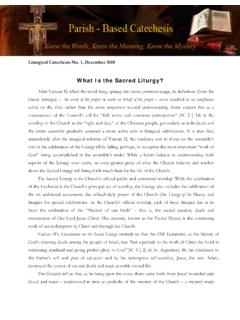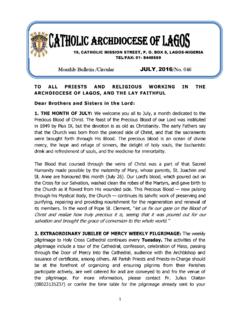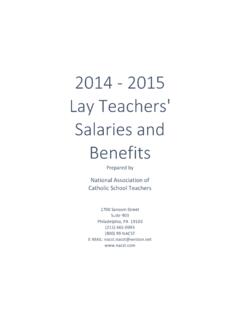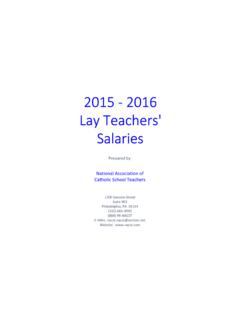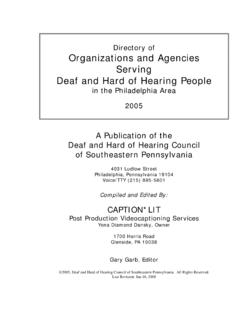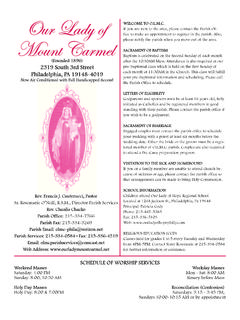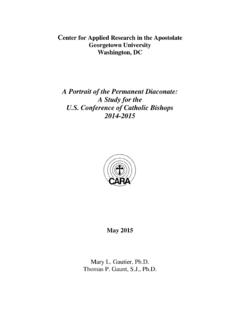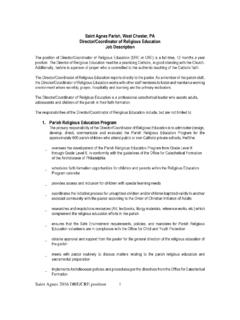Transcription of Published originally in Dec. 2009 LifeCycles newsletter ...
1 Published originally in Dec. 2009 LifeCycles newsletter ( for philadelphia natural Family Planning Network, ): NFP and Premenopause By Tara Plymouth, MTS At the Family Life Office, we have received many calls over the past year by women having difficulty interpreting their NFP charts during the premenopausal period. This is a very important issue to many couples who are in their 40 s and 50 s. Menopause is clinically defined by the permanent cessation of menstrual periods for one year. Half of all women experience menopause by around age 50, but it can occur earlier or Premenopause is the time before menopause, beginning generally around age 43, when a woman s fertility starts to wind down Some differences in the monthly cycle that women can expect during premenopause (and which sometimes make interpreting NFP charts difficult) include: Ovulation occuring early, late, or not at all in a cycle Mucus patches (one or more days of mucus, followed by dry days), due to fluctuating estrogen levels Longer or shorter periods or cycles Breakthrough bleeding (non-menstrual spotting in the middle of the cycle) Mucus quality and quantity decreasing A lower temperature rise after ovulation All of these changes occur for several reasons.
2 The ovaries and egg follicles don t respond to hormones as well; fewer follicles are present; the amount of hormones released may be less; and hormone levels may wax and wane. Also, each woman has her own pattern of hormonal fluctuations, and each woman s symptoms are related to many variables within her life. 3 The good news is, during the premenopausal time, NFP remains highly effective in avoiding pregnancy (for appropriately serious reasons), or in helping one to conceive. The key is that one must try to chart carefully every day, know how to interpret changes in one s fertility signs, and know who to contact for assistance. The Couple to Couple League (CCL) recently created a special premenopause NFP class and book, The Art of natural Family Planning Premenopause Guide. The book itself is an excellent guide for interpreting fertility signs during this time, and gives understandable explanations and graphics.
3 It can be purchased from CCL at ; one can also search for local CCL premenopause classes on that site. Another very helpful resource is the newly revised book, Fertility, Cycles, & Nutrition, by Marilyn M. Shannon. It has a special chapter on pre/perimenopause and menopause, detailing common symptoms during this phase of life and helpful suggestions and nutritional remedies. Sometimes it is necessary to talk to a person versed in NFP, in order to interpret fertility signs during this time. One can call one s NFP instructor, the Archdiocese of philadelphia NFP Office (215-587-3516), Diocese of Camden NFP Office (856-583-6120), or local doctor, Lester Ruppersberger, (215-750-6611) at such times. Also, some organizations can provide knowledgable and helpful support: CCL (800-745-8252) or Creighton Model FertilityCareTM: 1 Couple to Couple League International, The Art of natural Family Planning: Premenopause Student Guide (Cincinnati, OH: Couple to Couple League International, 2009 ), 9.
4 2 Ibid.; Christelle Hagen, Easing the Mid-life Transition: CCL Launches New Class and Book for Premenopause, Family Foundations (July/August 2009 ): 16. 3 Couple to Couple League International, 12.
